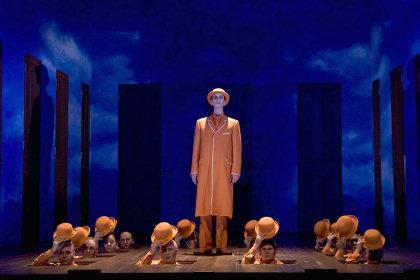|
Editor: Marc Bridle
Webmaster: Len Mullenger
|
Seen and Heard Opera
Review
Magritte's paintings and Tim Guest's book My Life in Orange are two of the major influences at work for director Dominic Cooke and designer Julian Crouch in this new Magic Flute. The same three walled set, painted with Magritte's fluffy-clouded skies, is used in both acts and the uniform in Sarastro's realm (including that for the women) is a frock-coated orange suit complete with bowler and brolly. Surrealism then, mixed with direct reference to the Bhagwan Shree Rajneesh community and vaguely Buddhist overtones are the (Holy) Orders for the Evening.
There's precious little ambiguity though, because the idea that Tamino's journey (like every spiritual venture surely) happens mostly in his mind, is made explicit from the outset. Jacketless but otherwise dressed for dinner, Tamino finds himself alone in the nine-doored room, attacked by a giant lobster. When the Three Ladies arrive come to his rescue, they're kitted out as parlour maids. It's a dream sure enough and we're never allowed to forget it.
To be fair to Dominic Cooke though, balancing the portrayal of a mystical journey with a good deal of knockabout comedy isn't the easiest of tasks; choosing to get Tamino out of Japanese hunting garb and showing Sarastro's domain as a cult dedicated to idealism (as the Bhagwan's was in the beginning at least) are wholly laudable conceptions. But the remorselessness of the symbolism does become tedious; so tedious in fact that a critic not far from me groaned audibly when Sarastro's acolytes popped up through their trap doors. An encore must have been hard to resist when the guardians of the fire and water rituals (in bowler hats rather than armour, naturally) turned up dressed in red and blue, head to foot. No prizes (no, none) for guessing.
Rebecca Evans (Pamina) and the Three Boys
The comedy worked pretty well however. Teddy Tahu Rhodes sang strongly as Papageno, showed real talent as an actor, and when partnered by Claire Hampton's Papagena (no slouch with a daft northern accent as well singing feistily) provided a good dollop of much-appreciated humour. Monostatos' henchmen (black suits and bowlers) did a passable imitation of the Ministry of Silly Walks when dancing to Papageno's chimes and the Three Boys raised some giggles while pedalling over the stage on a balloon-borne cycling machine complete with an animal's head and tail.
The undoubted star of the show was Rebecca Evans as Pamina. Hers is a marvellous voice these days with rich full tone in its lower range matched by superbly controlled and smooth upper reaches. The soft, floated high notes were especially memorable, expressing such sensitivity that it is hard to imagine a better performance.
Brindley Sherratt (Sarastro), Peter Wedd (Tamino) and Philip Lloyd Holtam (Monostatos) all gave competent perfomances but this was not the case, unfortunately, with Katarzyna Dondalska who struggled considerably as the Queen of Night. Her high Fs seemed reasonably secure but her transitions between vocal registers came over as particularly problematic. This was not a performance to equal her previous successes at WNO.
Overall then, the production is something of a mixed bag and despite Jean-Yves Ossonce's treatment of it as a chamber work, it felt curiously uninvolving both as concept and as musical experience. The audience loved it though and it could well settle down as the run continues.
Bill Kenny
Rebecca Evans (Pamina) and Peter Wedd (Tamino)
Pictures © Bill Cooper
Back to the Top Back to the Index Page |
| ||
|
||||





